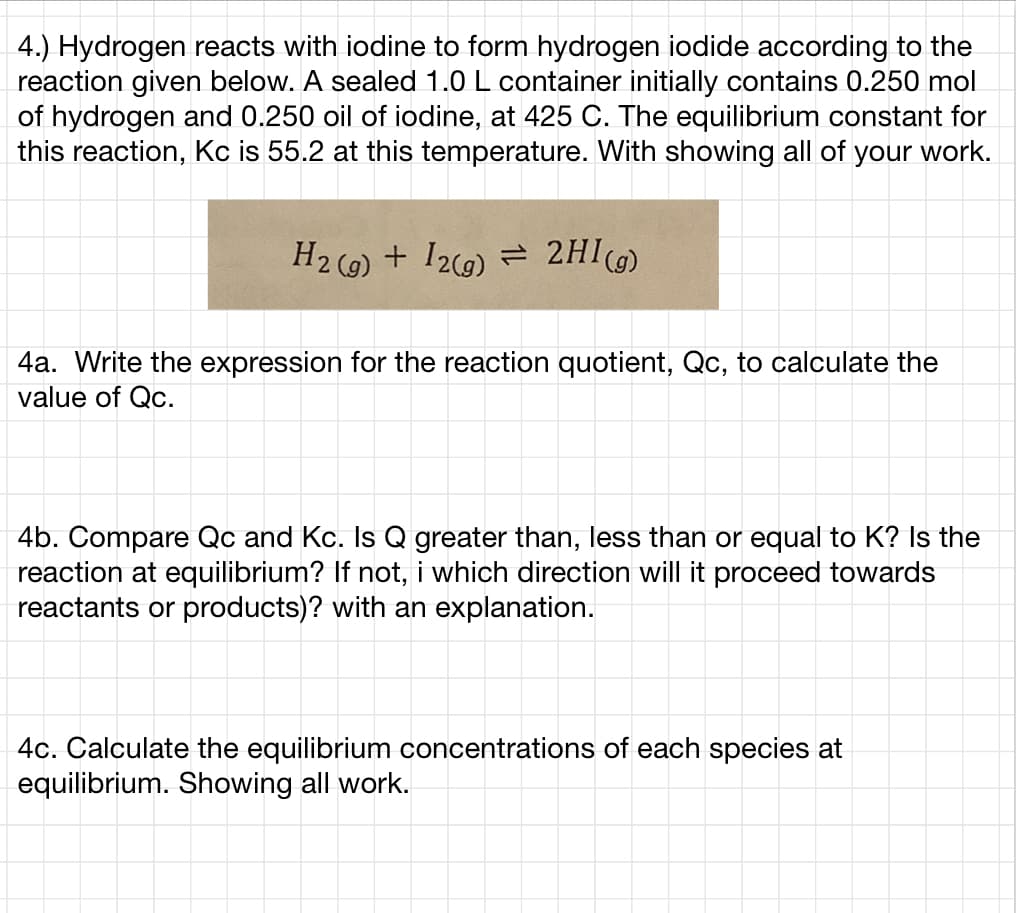4.) Hydrogen reacts with iodine to form hydrogen iodide according to the reaction given below. A sealed 1.0 L container initially contains 0.250 mol of hydrogen and 0.250 oil of iodine, at 425 C. The equilibrium constant for this reaction, Kc is 55.2 at this temperature. With showing all of your work. H2 (6) + 12c) = 2HI) e 2HIG) 4a. Write the expression for the reaction quotient, Qc, to calculate the value of Qc. 4b. Compare Qc and Kc. Is Q greater than, less than or equal to K? Is the reaction at equilibrium? If not, i which direction will it proceed towards reactants or products)? with an explanation. 4c. Calculate the equilibrium concentrations of each species at equilibrium. Showing all work.
4.) Hydrogen reacts with iodine to form hydrogen iodide according to the reaction given below. A sealed 1.0 L container initially contains 0.250 mol of hydrogen and 0.250 oil of iodine, at 425 C. The equilibrium constant for this reaction, Kc is 55.2 at this temperature. With showing all of your work. H2 (6) + 12c) = 2HI) e 2HIG) 4a. Write the expression for the reaction quotient, Qc, to calculate the value of Qc. 4b. Compare Qc and Kc. Is Q greater than, less than or equal to K? Is the reaction at equilibrium? If not, i which direction will it proceed towards reactants or products)? with an explanation. 4c. Calculate the equilibrium concentrations of each species at equilibrium. Showing all work.
Chemistry: The Molecular Science
5th Edition
ISBN:9781285199047
Author:John W. Moore, Conrad L. Stanitski
Publisher:John W. Moore, Conrad L. Stanitski
Chapter12: Chemical Equilibrium
Section: Chapter Questions
Problem 61QRT
Related questions
Question

Transcribed Image Text:4.) Hydrogen reacts with iodine to form hydrogen iodide according to the
reaction given below. A sealed 1.0 L container initially contains 0.250 mol
of hydrogen and 0.250 oil of iodine, at 425 C. The equilibrium constant for
this reaction, Kc is 55.2 at this temperature. With showing all of your work.
H2 (e) + I29) = 2HI)
4a. Write the expression for the reaction quotient, Qc, to calculate the
value of Qc.
4b. Compare Qc and Kc. Is Q greater than, less than or equal to K? Is the
reaction at equilibrium? If not, i which direction will it proceed towards
reactants or products)? with an explanation.
4c. Calculate the equilibrium concentrations of each species at
equilibrium. Showing all work.
Expert Solution
This question has been solved!
Explore an expertly crafted, step-by-step solution for a thorough understanding of key concepts.
This is a popular solution!
Trending now
This is a popular solution!
Step by step
Solved in 2 steps with 1 images

Follow-up Questions
Read through expert solutions to related follow-up questions below.
Follow-up Question
How do you calculate the equilibrium concentrations of each species at equilibrium?
Solution
Knowledge Booster
Learn more about
Need a deep-dive on the concept behind this application? Look no further. Learn more about this topic, chemistry and related others by exploring similar questions and additional content below.Recommended textbooks for you

Chemistry: The Molecular Science
Chemistry
ISBN:
9781285199047
Author:
John W. Moore, Conrad L. Stanitski
Publisher:
Cengage Learning

Introduction to General, Organic and Biochemistry
Chemistry
ISBN:
9781285869759
Author:
Frederick A. Bettelheim, William H. Brown, Mary K. Campbell, Shawn O. Farrell, Omar Torres
Publisher:
Cengage Learning

Principles of Modern Chemistry
Chemistry
ISBN:
9781305079113
Author:
David W. Oxtoby, H. Pat Gillis, Laurie J. Butler
Publisher:
Cengage Learning

Chemistry: The Molecular Science
Chemistry
ISBN:
9781285199047
Author:
John W. Moore, Conrad L. Stanitski
Publisher:
Cengage Learning

Introduction to General, Organic and Biochemistry
Chemistry
ISBN:
9781285869759
Author:
Frederick A. Bettelheim, William H. Brown, Mary K. Campbell, Shawn O. Farrell, Omar Torres
Publisher:
Cengage Learning

Principles of Modern Chemistry
Chemistry
ISBN:
9781305079113
Author:
David W. Oxtoby, H. Pat Gillis, Laurie J. Butler
Publisher:
Cengage Learning

Chemistry for Engineering Students
Chemistry
ISBN:
9781337398909
Author:
Lawrence S. Brown, Tom Holme
Publisher:
Cengage Learning

Chemistry: Principles and Reactions
Chemistry
ISBN:
9781305079373
Author:
William L. Masterton, Cecile N. Hurley
Publisher:
Cengage Learning

General, Organic, and Biological Chemistry
Chemistry
ISBN:
9781285853918
Author:
H. Stephen Stoker
Publisher:
Cengage Learning